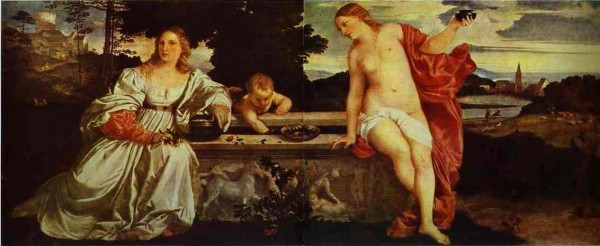
Titian (1488-1576), Sacred and Profane Love, c. 1513-1514. Oil on canvas, 46 x 110 in. Galleria Borghese, Rome
This is the fourth installment of our Museum and Memory series for International Museum Day. Read parts one, two, and three.
It was a sultry day in the fall of 2001 when I went traipsing through Rome’s Borghese gardens on a quest. My mission was to see a famous painting housed in the Villa Borghese’s painting gallery, the Pinacoteca, for a Venetian Renaissance art class I was taking. I was a recent transfer to a university in Rome and had committed to move abroad for two years to complete my undergraduate degree as an art history major. Although I had been an art aficionado since childhood, I hadn’t yet truly fallen in love—until then.
As I said, it was hot. I had a delicious gelato on my walk over (raspberry and vanilla, I distinctly remember). I was still licking my lips while waiting in line to enter the Pinacoteca. As my ticket was timed, I only had about an hour to find the painting and gather my thoughts for the essay before heading out. I climbed the narrow stone spiral stairs that led to the upstairs galleries and began my search.
I wandered amongst stately Raphael tondi and statues of slumbering putti before rounding the corner to the very last gallery when I saw it. It stopped me in my tracks. It was the sexiest thing I’d ever seen. Titian’s Sacred and Profane Love was lush, ripe, and sensuous. The dense, glazed layers of paint didn’t just sit on the canvas, they glowed. The citrusy red and creamy white drapery that caressed the pale flesh of Titian’s female protagonists made me swoon. I wanted to lick those colors right off the canvas, convinced that they would taste like the raspberry and vanilla gelato I had just eaten. It was, without a doubt, the first moment that I realized art could physically grab you by the lapels, or, in this case, seduce you at first glance.
That moment is what has directed my course ever since and is arguably why I find myself working in a museum years later. I live for these moments with an artwork that leave me so smitten, moved, or jarred that everything else melts away.
Amanda Jirón-Murphy, In-Gallery Interpretation and Public Programs Coordinator

